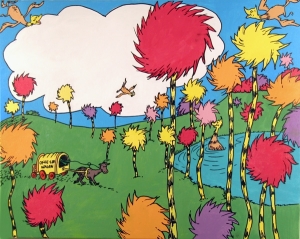 Internet of Things: “a world where physical objects are seamlessly integrated into the information network, and where the physical objects can become active participants.” — Stephan Haller, SAP Research, 2009
Internet of Things: “a world where physical objects are seamlessly integrated into the information network, and where the physical objects can become active participants.” — Stephan Haller, SAP Research, 2009
“This thing is a Thneed. A Thneed’s a Fine-Something-That-All-People-Need” —The Once-ler, 1971
With the proliferation of wearable technology, RFIDs, self-driving cars and the Quantified Self movement, it’s clear that The Internet of Things has moved beyond trendy, PowerPoint slide fodder and into the Real World of Things.
In the wearables market alone, sales are expected to leap 129 percent by year’s end, hitting 22 million shipments by 2015 and a Google-Glass-shattering 135 million by 2018, according to CCS Insight. A Gartner report predicts the existence of 26 billion devices comprising the Internet of Things (IoT) by 2020.
To better gauge where “Things” are headed, Pew Research asked 1,606 experts:
“As billions of devices, artifacts, and accessories are networked, will the Internet of Things have widespread and beneficial effects on the everyday lives of the public by 2025?”
The experts shouted a resounding: “Yes!” as 83% agreed with Pew’s thesis question.
Salesforce.com chief scientist and survey participant JP Rangaswami waxed poetic about IOT’s potential. He writes:
“The proliferation of sensors and actuators will continue. The quality of real-time information that becomes available will take the guesswork out of much of capacity planning and decision-making. This will affect the food you buy and cook and eat; the fuel you use to power yourself, your devices, and your vehicles; the time you take to do things; and, as you learn to live longer, the burden of care will reduce as a result of far better monitoring of, and response to, your physical and emotional state, in terms of healthcare. People will engage with information using all of their senses: touch and feel, sight, sound, smell, and taste—using them in combination, more often than not. Wearable, connected devices will become embedded more and more in our bodies, more like implants, as in the [Google] Glass becoming more like contact lenses.”
As technology evolves, individual parts of the whole move from Want to Need. In the 1980s, mounting a computer on every desktop for most businesses was a Want — “It would be nice..but we can’t afford it.” Fast forward to 2014, and that same computer-less business would measure its shelf life in nanoseconds.
But in between Want and Need is yet another subdivision — the Thneed. You’ll recall the Thneed from Dr. Seuss’ cautionary tale The Lorax. The book follows the rise and fall of the ultra-capitalist Once-ler as he ramps up production of thousands of Thneeds (which were apparently the Swiss Army Knife equivalent of a Snuggy).
 To make a short story shorter (and let’s just table the fate of the poor Truffula trees for now), the Thneed didn’t start out as a Need. In fact, people didn’t know Thneeds existed until the Once-ler began to manufacture them.
To make a short story shorter (and let’s just table the fate of the poor Truffula trees for now), the Thneed didn’t start out as a Need. In fact, people didn’t know Thneeds existed until the Once-ler began to manufacture them.
Once word got out (we assume the Suessian denizens had Engadget), the Thneed became the Prime Want (the iPhone, the Galaxy, the Kindle). People lined up for hours outside Truffula Stores. Before the Thneed could cross over from Want to legitimate Need, however, the Once-ler decimated the environment and resources at “the far end of town where the Grickle-grass grows.”
Ultimately, the Thneed occupied an in-between niche, in that, people not only wanted them, but almost “needed them” to live their version of a self-actualized, modern life.
Right now, full deployment of the Internet of Things is a Want — a Wow Factor underscoring what is already the greatest Era of Wow our species has yet encountered. Our economy won’t grind to a halt if every manufacturer fails to employ RFID inventory control; we won’t see a spike in heart attacks for lack of FitBits.
However, as the experts already foresee, the shift from Want to Thneed will come. And by 2025, the Thneed will transition to a Real Need. Our precious planetary resources will require the kind of laser-focused management that only a network of Big Data-driven devices, implants and actuators can likely provide.
To again quote Rangaswami:
“The net effect will be to reduce waste everywhere: in physical flows and logistics, in the movement of people and goods; in logical flows and logistics, in the movement of ideas and information; decisions will be made faster and better, based on more accurate information; prior errors in assumption and planning will be winkled out more effectively.”
From a Transhumanist perspective, the inevitability of the Internet of Things will play a pivotal role in human longevity. Incrementally, we will continue to deploy network-capable devices both near, on and inside our bodies as a means of monitoring, measuring and enhancing our health.
“The population curve … will cause much of the monitoring and assistance by intelligent devices to be welcomed and extended,” said University of North Carolina Paul Jones in the Pew survey. “This is what we had in mind all along—augmented life extension.”
Our challenge: To shape this technology from an “Ain’t It Cool” Want to a sustainable Thneed (and protect those Truffula trees) until The Internet of Things settles into its rightful role as a Need in our journey of enhanced human evolution.

I’d be interested in sharing this article in h+ Magazine. Contact peter @hplusmagazine.com if you would be interested.
LikeLike